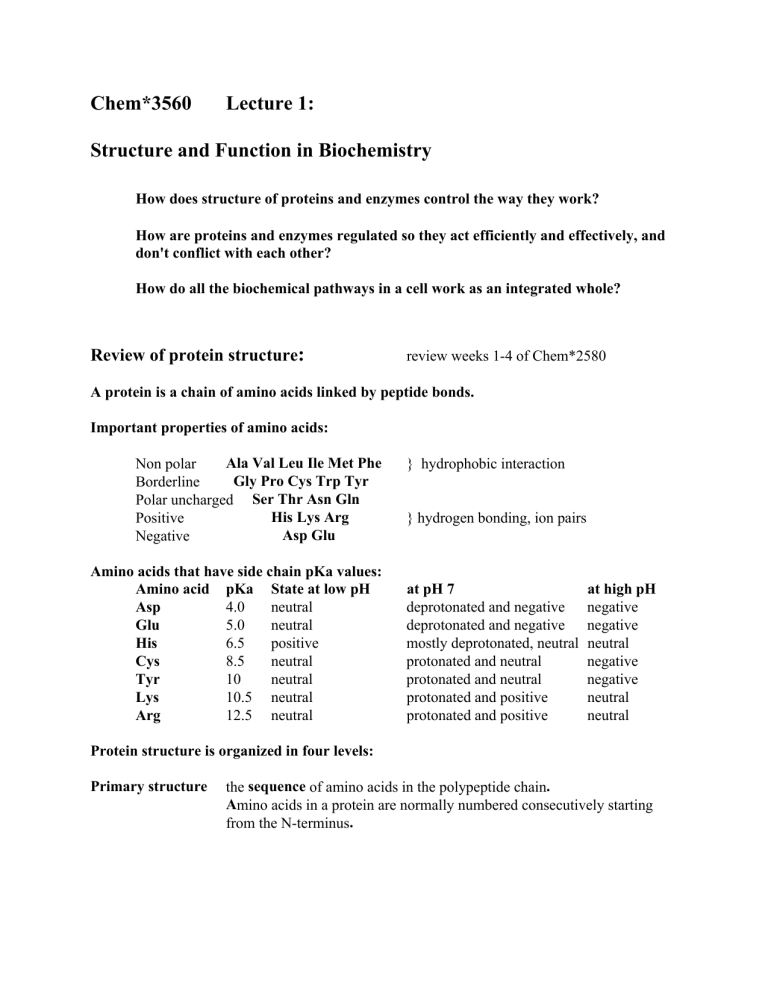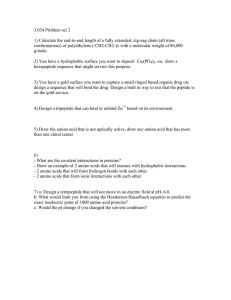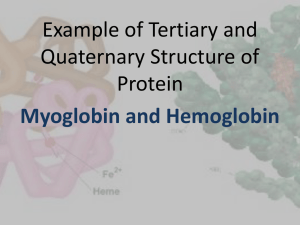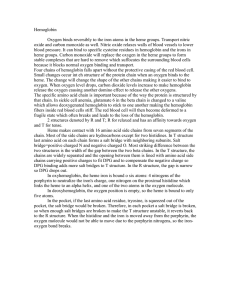
Chem*3560 Lecture 1: Structure and Function in Biochemistry How does structure of proteins and enzymes control the way they work? How are proteins and enzymes regulated so they act efficiently and effectively, and don't conflict with each other? How do all the biochemical pathways in a cell work as an integrated whole? Review of protein structure: review weeks 1-4 of Chem*2580 A protein is a chain of amino acids linked by peptide bonds. Important properties of amino acids: Ala Val Leu Ile Met Phe Non polar Gly Pro Cys Trp Tyr Borderline Polar uncharged Ser Thr Asn Gln His Lys Arg Positive Asp Glu Negative Amino acids that have side chain pKa values: Amino acid pKa State at low pH Asp 4.0 neutral Glu 5.0 neutral His 6.5 positive Cys 8.5 neutral Tyr 10 neutral Lys 10.5 neutral Arg 12.5 neutral } hydrophobic interaction } hydrogen bonding, ion pairs at pH 7 deprotonated and negative deprotonated and negative mostly deprotonated, neutral protonated and neutral protonated and neutral protonated and positive protonated and positive at high pH negative negative neutral negative negative neutral neutral Protein structure is organized in four levels: Primary structure the sequence of amino acids in the polypeptide chain. Amino acids in a protein are normally numbered consecutively starting from the N-terminus. Secondary structure regular repetitive patterns such as alpha helix and beta sheet held together by backbone hydrogen bonds Alpha helix is the default preference Helix of 3.6 AAs per turn, H-bonds from CO group i to NH group i + 4 Ala, Leu, Met, (Phe), Glu, Gln, His, Lys, Arg Extended strands may be arranged as parallel or antiparallel beta sheets, with H-bonds between CO and NH in adjacent strands. Extended polypeptide leaves the maximum room for the side chain, hence bulky amino acids prefer beta sheet Val, Ile, Thr, Cys, Trp, Tyr, (Phe) Amino acids that disrupt secondary structure and give rise to turns or loops Gly, Pro, Asp, Asn, Ser Tertiary structure The overall pattern of folding, determined by the distribution of secondary structure: alpha-helix bundles, mostly α antiparallel beta barrels, mostly β alternating α and β parallel beta/alpha barrels alpha-beta sandwich hydrophobic effect, van der Waals effect, side-chain H-bonds ion pairs Myoglobin structure shown is about 75% alpha helix in a chain of 153 amino acids. See Lehninger p.203. Folded pattern is held together by Quarternary structure Association of multiple protein subunits into a larger complex. The different subunits act cooperatively to enhance the function of the protein Hemoglobin, right, is a tetramer of four myoglobin-like subunits, Lehninger p.210. Many proteins bind and recognize other molecules Ligand: any substance bound by another molecule (Lehninger p. 203-204) Ligands may bind to proteins, and may be described according to specific functions: A ligand that binds to an enzyme and participates in a catalytic reaction may be called a substrate. A ligand that binds to an enzyme and does not participate in reaction, but slows down catalysis of other substrates may be called an inhibitor. A ligand that binds to an enzyme and does not participates in reaction, but regualtes catalytic activity may be called an effector. The term ligand is also applied to small molecules that bind to metal ions to form complex ions, e.g. H2O in [Fe(H2O)6]2+, NH3 in [Ni(NH3)6]3+ Ligands bind to metals by donating lone pairs. Particular metal ions have specific patterns of ligands 4 ligands, tetrahedral or square planar Proteins may change shape when they bind a ligand Ligands bind to a protein which has a binding site which: matches hydrophobic regions in protein and ligand; is complementary in shape; matches up pairs of opposite charges; matches up H-bond donors with H-bond acceptors. 6 ligands octahedral, When a ligand binds to a protein, it alters the balance of internal forces in the protein. Since protein structure is based on relatively weak forces, proteins have a degree of flexibility, and the protein will adjust its overall shape or conformation when a ligand such as a substrate or effector binds. This kind of change is known as induced fit. In many cases, induced fit causes an enzyme to close up around the bound substrate, in particular, the second substrate of a two substrate reaction. This is well illustrated by hexokinase, which must bind both ATP and glucose for catalysis to happen: ATP + glucose → ADP + glucose-6-phosphate When both substrates are present, hexokinase wraps around the bound glucose, and only then does the enzyme adopt the correct alignment of substrate and catalytic amino acids. (Lehninger p.275-276.) The problem that this solves is that the mechanism which activates the glucose-6-OH group to act as a phosphate acceptor, could also activate an H2O molecule. Since the reaction is conducted in aqueous solution, if glucose is not yet present, H2O molecules will occupy the acceptor site. If induced fit was not part of the mechanism, hexokinase could catalyse reaction of ATP with H2O, or in other words, bring about undesired hydrolysis of ATP. Instead, the enzyme does not adopt the ideal catalytic conformation until glucose is present, preventing reaction with wrong substrates. As a further illustration, D-xylose is the pentose sugar that has the identical configuration to the first 5 carbon atoms of glucose. Hexokinase can bind D-xylose, leaving the room for H2O in the gap left by the missing 6th carbon. D-xylose triggers the induced fit effect, so that the catalytic amino acids become aligned, and as a result ATP hydrolysis occurs. Oxygen binding proteins (Lehninger p.204) Myoglobin is an O2-binding protein for storing oxygen in muscle (particularly abundant in diving animals such as whales and seals). Hemoglobin is an O2-binding protein present in red blood cells. Hemoglobin transports O2 from lungs to peripheral tissues. Both hemoglobin and myoglobin are composed of closely related globin proteins (see Lehninger p. 210-211 and Fig. 7.7) and heme pigment (Lehninger p.205), which gives blood its characteristic red colour. Since amino acids don't possess O2-binding ability, globins recruit heme to act as a prosthetic group to carry out the O2-binding. An apoprotein refers to a polypeptide that requires an additional non-amino acid component to carry out its function. A prosthetic group is a molecule that carries out some function that amino acids can't perform. A holoprotein refers to the complete functional unit of apoprotein + prosthetic group. Also: apoenzyme + prosthetic group = holoenzyme for proteins with a catalytic role. Globin proteins are designed to bind heme: Globin consists of a bundle of 8 helical segments, labelled A-H (Helix A is closest to N-terminus, then in order through to H at the C-terminus). Different globins have different chain lengths (Lehninger p. 211). To relate different locations in the structure it is common to refer to position within each helical segment rather than position in the whole sequence. Thus His F8 is the 8th amino acid in helix F, and plays identical roles in different globins. O2 binds to Fe2+ within the heme Both globin and heme play important roles that allow Fe2+ to bind O2 reversibly, so that O2 can be released when needed. O2 normally oxidizes Fe2+ to Fe3+, and this releases reactive and toxic oxygen derivatives such as •OH free radicals. This oxidation affects both free aqueous Fe2+ ions and Fe2+ in heme. The role of globin is to protect against oxidation. Heme is protoporphyrin IX containing bound Fe2+ Porphyrins are molecules made up from four repeating units containing the pyrrole ring, a 5-member ring with one N atom. Each pyrrole carries one methyl group and a propionate side chain. The pyrrole rings are linked together through a bridging –CH= group. Molecules of this type are described as tetrapyrroles, and may be linear or cyclic. Protoporphyrin IX is cyclic, and two of the propionate side chains have been decarboxylated to form vinyl side chains –CH=CH2. The four pyrrole N atoms form a square planar array at ideal spacing to act as ligands for metal ions such as Fe2+. This locks Fe2+ in place with high affinity, so all cellular Fe2+ will effectively be sequestered in the form of heme. Heme can be bound by various kinds of protein, and the function of the heme depends on the organization within the protein: Globins bind heme so as to prevent oxidation to Fe3+, so O2 can be bound reversibly. Various cytochromes also bind heme, but allow the heme to be reversibly oxidized to ferriheme containing Fe3+. The cytochromes do not bind O2, and the oxidations and reductions are part of the electron transport process of oxidative phosphorylation and photosynthesis. Heme binds to globin in a slot between helix E and Helix F The N atoms of heme form a square planar array of ligands for the Fe2+, which actually prefers 6 ligands in an octahedral complex. Ligand 5 is provided by His F8 of the globin. Ligand 6 is free to be occupied by a molecule of O2. The position of His E7 next to ligand 6 forces a diatomic ligand to bind to Fe2+ at an angle. This favours O=O, but disfavours C ≡ O, which binds straight on (remember Lewis structures and the orientation of lone pairs from first year Chemistry). Position 7 in helix E is consistently His in different froms of globin. This effect is important, because the affinity of C ≡ O for Fe2+ is normally 20,000 times stronger than O2. Affinity for C ≡ O in myoglobin is still about 20 times stronger than O2, but the difference in affinities is less pronounced. Since C ≡ O readily displaces O2, but O2 has difficulty displacing C ≡ O, this accounts for the toxic effects of carbon monoxide. Globin protects Heme-Fe2+ from oxidation to Fe3+ Simple aqueous Fe2+ ion and soluble heme-Fe2+ are both oxidized to Fe3+ in the presence of O2. The oxidation mechanism requires two heme-Fe2+ molecules to sandwich a single O2. Oxidation converts heme to ferriheme which contains Fe3+, and changes the ligand preferences of the metal ion. Fe3+ binds H2O as ligand 6, so the O2 binding capability is lost. When heme is embedded in globin, the presence of protein surrounding the heme physically obstructs the close approach of two hemes, so that the sandwich arrangement that is necessary for oxidation can't form. As a result, heme-Fe2+ within a globin protein is not easily oxidized, and instead can bind and release O2 in a reversible manner. This is key to the function of these proteins.


